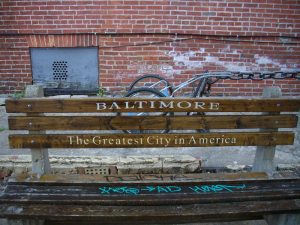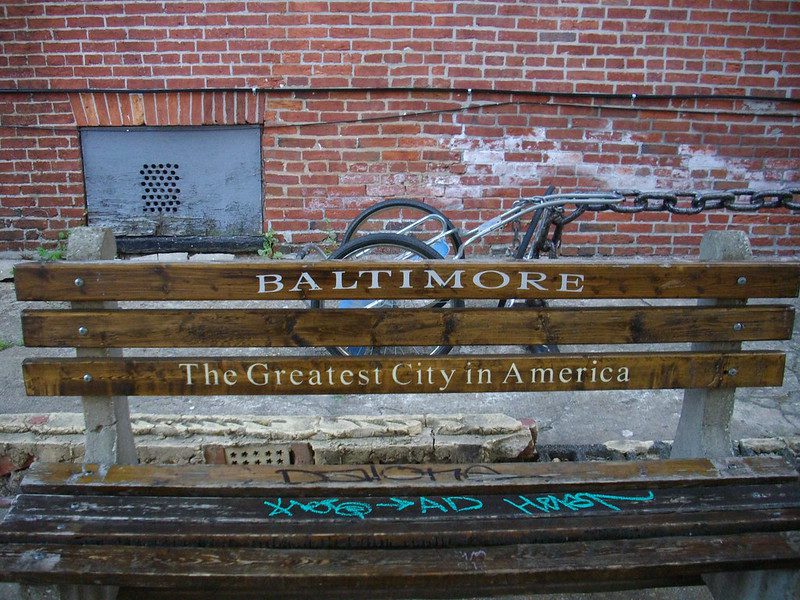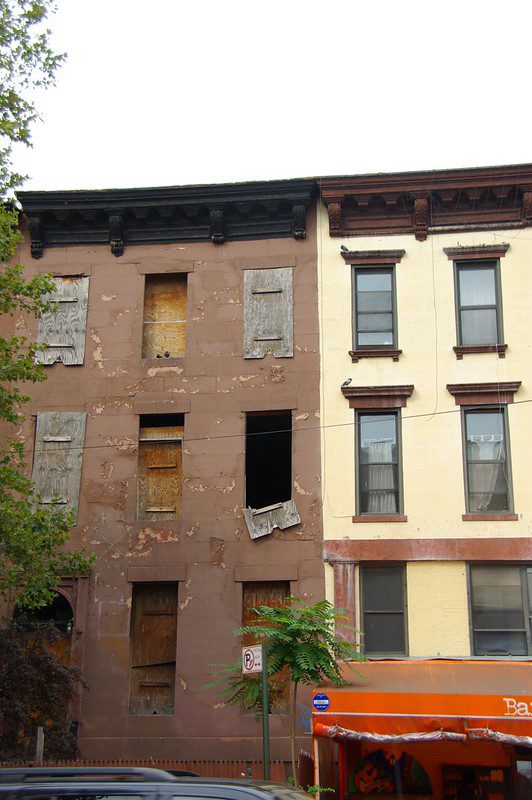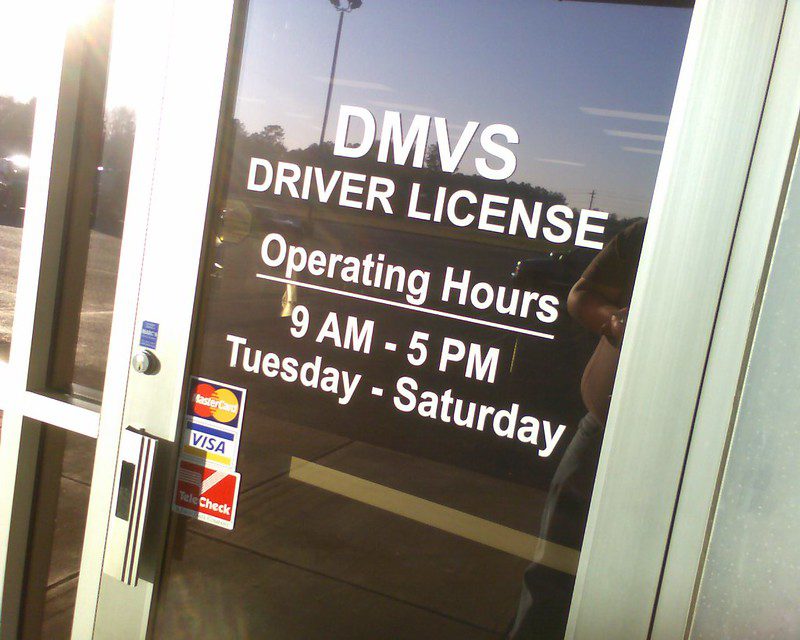
Photo by Flickr user shootingsawk, CC BY-NC-ND 2.0
At first glance it would seem hopeless: hundreds of run-down rental properties that make cells in the City Jail look like luxury apartments. Vacant houses left open to drug dealers. Frustrated renters close to despair with burst pipes, no heat in the winter, children at risk of lead paint poisoning and rat bites. A city housing agency stretched so thin it cannot enforce code violations. To top it off, the landlord responsible for it all files bankruptcy. It is a scenario familiar to every inner city across America. In Baltimore, however, the “end” of this bleak story is being rewritten with the help of the Community Law Center.
On Feb. 2, 1994, in a landmark case for Maryland, the tenants of R. William Connolly Jr., with the help of the Community Law Center, won a major victory in United States Bankruptcy Court. Federal Judge James Schneider approved a plan proposed by the Law Center on behalf of the tenants to appoint a third party property administrator to make repairs at Connolly’s 574 dilapidated rental properties. The Law Center plan also established a repair fund comprised of 40 percent of all monthly rents or $35,000 per month, whichever is greater. This figure is low because Baltimore rents are very low compared to those in other cities; the average is $300 per month.
Connolly is the first large Baltimore landlord to file for Chapter 11 bankruptcy. The goal of Chapter 11 bankruptcy is to reorganize a business and become solvent in order to pay off creditors to the extent possible. Connolly’s June 1993 filing could have allowed him to use rent money collected to pay off creditors before making promised repairs on his properties. The filing would also have given him protection against liability for numerous lawsuits concerning lead paint poisoning of children who live in his apartments.
Of the 574 Connolly properties – including some multi-family units – 200 had “vacant violation notices” declaring them unfit for habitation but open to passers-by, at the time of the bankruptcy filing, an additional 173 had outstanding and uncorrected housing code violations. Many others had dangerous conditions in violation of the housing code but had not been inspected by the city. Most of the vacant properties were not boarded, were used as crack houses and “shooting galleries” and were nuisances to the surrounding neighborhoods.
Many tenants were initially lured into renting from Connolly by incentives like a waiver of their security deposit or the first month’s rent free, with promises that needed repairs would be made before they moved in.
Not only were repairs not made, but Connolly charged above the market rate rents. Tenant Addie Davis pays $360 a month in rent out of her $434 social security check. Davis, who is 66, can’t afford to move and doesn’t want to leave her home. She has lived there 18 years, five of them before Connolly bought her home as an investment. Since January, she’s asked for a railing for her steps because of her arthritis. “My roof leaks bad. Leaks all through the electric in the bathroom; through the light fixture.” As bad as Davis’s home is, it’s in far better condition than most other Connolly properties.
With the health and welfare of so many tenants at stake, the Law Center had to find an effective way to solve the problems that Connolly had created through so many years of neglect. Many groups, both nonprofit and governmental, had tried with little success. The Law Center was convinced that new, creative strategies were needed. “When looking at 574 units in need of massive repairs, and in which hundreds of people are currently living in horrible conditions,” Denise Duval, the Law Center staff attorney on the Connolly case, explains, “we must ask: ‘How can we improve this disastrous situation in the most effective, efficient and orderly way?’ We struggled to represent the tenants in a way that would make the most impact. We considered and rejected a number of strategies before we decided on this one.”
In the Connolly case, the Law Center’s work was made all the more challenging by the fact that tenants have few legal rights and often, poor credit. Many of them are living one step away from homelessness. It was crucial to choose a strategy that would not expose individual tenants to scrutiny, but would meet their needs for better conditions.
The tenants’ and the Law Center’s first small victory came after Connolly declared bankruptcy. Duval and a specific tenant with a unit in need of repair showed up in federal bankruptcy court at the first meeting of creditors and argued to the U.S. Trustee that tenants were “creditors” because Connolly owed them repairs and habitable housing. The U.S. Trustee agreed and appointed Duval to the “Official Committee of Unsecured Creditors” to represent the interests of the tenants. This committee is appointed by the court for all Chapter 11 bankruptcy cases in order to direct the proceedings. The decision permitting Duval to represent tenants came in spite of the fact that most tenants had no claims pending in courts of law.
“Taking on the Connolly case,” says Anne Blumenberg, Executive Director of the Community Law Center, “is exactly in line with what we try to do, because it uses the law to enable people to have practical solutions to their problems. Participation on a creditors’ committee in federal bankruptcy court is normally inaccessible to our clients. We strive to use the legal system for the betterment of low-income communities.”
The tenants’ highest priorities were to require Connolly to spend a significant portion of their rental payments – his income – on repairs, and to have the repairs done well and efficiently. Tenants informed the Law Center that Connolly was not adequately repairing their homes. “We decided that we had to take the repair function away from Connolly, and hire someone with the experience and ability to do the repairs well,” says Duval. “No one trusted that, without an administrator, Connolly would actually spend repair fund monies on repairs.” The Community Law Center worked with the tenants, the other creditors, the city’s Department of Housing and Community Development, the State Attorney General’s office, and Baltimore Neighborhoods, Inc. to promote the administrator idea.
The Unsecured Creditors’ Committee, consisting mostly of businesses who supplied Connolly with materials and services, had to be convinced that it was in their interest to use rental income for repairs on the properties. Duval argued that the properties were the largest assets in the case, and that the only way to ensure that creditors would get paid was to repair the properties so that they would continue to generate income. In bankruptcy jargon, this is known as “preserving the assets of the estate.” Duval also convinced the Committee that the only way to repair the properties was to have someone other than Connolly do the repair work. She dramatically demonstrated that he had a long history of failure to maintain his properties as habitable housing.
On Nov. 30, 1993, the Creditors’ Committee filed a “Motion to Appoint A Property Administrator.” Between that date and the February, 1994, hearing on the Motion, the Law Center and the tenants stepped into high gear to organize and prepare for the hearing. Their strategy included focusing on four neighborhoods where Connolly owned over 200 houses – in some cases entire blocks – and showing the court the conditions of these houses in all four neighborhoods.
”Once a hearing date was set and we chose the four target neighborhoods, we mobilized quickly. Approximately 15 tenants who were already involved led the efforts,” Duval says. People helped circulate meeting notices, and entire block groups became involved in neighborhood strategy meetings at homes like Addie Davis’.
Door-to-door canvassing by CLC staff and Connolly tenants helped other Connolly tenants realize that they had the same landlord and similar concerns. They in turn encouraged other tenants to become involved and to testify at the hearing. Other community advocacy groups like Baltimore Neighborhoods, Inc. helped to spread the word as well.
A computer database program was developed at the Law Center to track the properties, their conditions and the occupants. Because of her position on the Creditor’s Committee, Duval also had access to Connolly’s financial records, and was able to determine and to track how much money had been spent on repairs for each property in the targeted neighborhoods.
As part of the organizing effort, the Law Center also enlisted the assistance of twelve University of Maryland Law School students to gather evidence and do outreach to tenants. The volunteers and staff took hundreds of photos, made a videotape of walk-throughs in several apartments with tenant narration, and created neighborhood maps with a flag on each Connolly property to be used as exhibits in court. Six tenants agreed to be witnesses and worked with Ms. Duval to prepare their testimony. On the day of the hearing, law students, Community Law Center staff and other volunteers coordinated a car pool system to transport the witnesses and nearly sixty other tenants to the federal courthouse.
One of the tenants appearing in court that day hobbled in slowly, using crutches. She had broken her leg falling through her bathroom floor, rotted from a leaking pipe that was never repaired. Other tenants spoke of living with no heat over the winter months. Tamara Sollers told the judge about burst water pipes, a broken toilet and many other problems that remained unattended to after endless calls and visits to Connolly’s office. “I don’t think Mr. Connolly or any of his lawyers would like to live like this, so why would I?” Ms. Sollers asked the judge. Federal Judge James Schneider agreed. He responded to the tenants by saying that their safety was his paramount concern.
After a resounding victory in court, a celebration party was held at the Community Law Center. At that party, tenants organized a Tenant’s Steering Committee consisting of six members. Tamara Sollers was elected president of the Committee, which was formed to both represent the tenants’ concerns to the Law Center regarding ongoing legal matters, and to keep other tenants informed of developments in the case.
On March 14, 1994, a search team, including the Law Center, chose an administrator for the Connolly properties – American Property Management Inc. (APM). APM has forged a collaboration with Housing America Through Training (HATT), a nonprofit organization created by the Home Builder’s Association of Maryland. HATT trains economically disadvantaged people in the construction trades and building and apartment maintenance while working on affordable housing projects.
APM hired the director of training at HATT to supervise the Connolly repair project. Two other HATT staff members are donating time as consultants to APM’s administration of the Connolly repairs. HATT is also donating their office and warehouse space to the effort. Two graduates of the HATT training program have been hired to work as part of the carpentry team put together by APM. As Ron Butts, the executive director of HATT, explains, “this is a win-win situation consistent with HATT’s mission; we improve housing conditions while building a skilled workforce.”
Chris Wright, the supervisor of APM’s Connolly repair crews, is working with the Connolly Tenant’s Steering Committee and Duval to set priorities for the repair work. “We wish we had a blank check so we could do all the repairs,” says Wright. “As it stands we only get $35,000 per month, so we are forced to make tough decisions about which repairs get done.”
Wright and his crews are faced with nothing short of a triage situation. “The problem is that practically every unit is an emergency situation. On a day-to-day basis, we have to decide which emergency is worse. I wish we could fix all of them right away, but we can’t.” APM is currently making over one hundred repairs per week at occupied Connolly properties and is cleaning and boarding another ten vacant properties per week.
The work of the administrator has been difficult, thwarted by Connolly at every turn in the months since the hearing. Connolly has not notified the administrator when he filed tenant eviction cases and has refused to allow APM to take tenant complaint calls directly. Further, he has not worked with the administrator when renting new apartments. Instead of putting tenants into properties the administrator has readied for new tenants, Connolly has moved people into houses with serious housing code violations and that are unfit for human habitation. The APM crews are currently working on units without water, electricity, functioning bathrooms or kitchens, and trying to do their work around tenants living there.
To counter these moves on Connolly’s part, the administrator requested greater control over the situation. On May 11, 1994, Judge Schneider ruled that Connolly could not extend his exclusive period for filing a plan of reorganization in the bankruptcy. Therefore, the Creditors’ Committee is now free to file its own plan to the Court for approval. Duval, who is now the President of the Creditors’ Committee, is drafting a plan that will give APM full control to manage the properties. The Court has indicated that it is anxious to see the Committee’s plan since the Committee is representing so many diverse interests.
In many ways, the hard work has just begun. It will be a challenge to make all needed repairs with limited resources. Deciding how to prioritize repairs is difficult, and undoubtedly, not everyone will be happy with the decisions made. Most tenants, like Tamara Sollers and Addie Davis, are patient and understand that the staggering need for repairs requires the triage approach.
“We worked together to take a situation that everyone said was impossible to solve, and we’ve made a step toward improving it,” Duval says with cautious optimism. “We have proven it can be done. Competent people are now managing Connolly’s resources wisely. That alone is having a big impact on the tenants and the neighborhoods.” As for Addie Davis, she maintains a hopeful outlook: “I would like things to change. They will if we pull together.”
For more information about the Connolly case or the work of the Center, contact staff attorney Denise Duval or Executive Director Anne Blumenberg at 2500 Maryland Ave., Baltimore, MD 21218; 410-366-0922.
When the Landlord Goes Bankrupt
The Community Law Center combines community organizing, legal advocacy and the coordination of diverse resources and organizations citywide to assist tenants and community organizations.
The hard-won victory in the Connolly case emerged out of the Community Law Center’s historic focus on receivership and its work with community residents. Beginning operation in 1986, the Community Law Center has worked with poor inner-city communities to develop strategies for addressing urban problems like vacant housing, drug-related activity and lead paint poisoning in children. Denise Duval and other Law Center staff attorneys provide legal services, technical assistance, and self-help materials for community-based organizations.






Comments